warning KIA Sephia 2009 2.G Owner's Guide
[x] Cancel search | Manufacturer: KIA, Model Year: 2009, Model line: Sephia, Model: KIA Sephia 2009 2.GPages: 291, PDF Size: 2.63 MB
Page 42 of 291
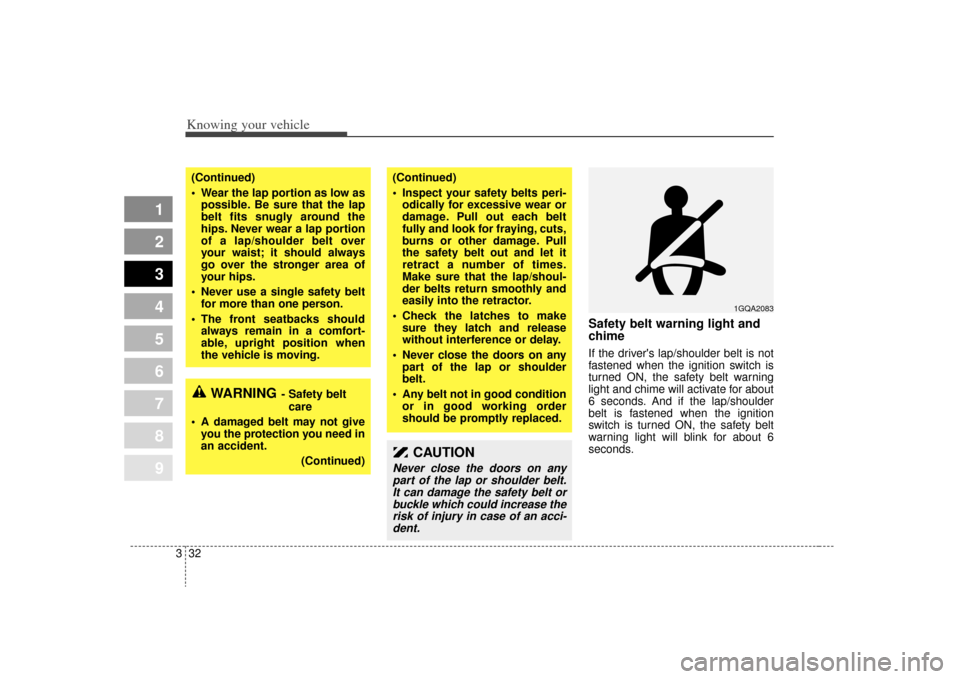
Knowing your vehicle32
3
1
2
3
4
5
6
7
8
9
Safety belt warning light and
chimeIf the driver's lap/shoulder belt is not
fastened when the ignition switch is
turned ON, the safety belt warning
light and chime will activate for about
6 seconds. And if the lap/shoulder
belt is fastened when the ignition
switch is turned ON, the safety belt
warning light will blink for about 6
seconds.
(Continued)
Inspect your safety belts peri-
odically for excessive wear or
damage. Pull out each belt
fully and look for fraying, cuts,
burns or other damage. Pull
the safety belt out and let it
retract a number of times.
Make sure that the lap/shoul-
der belts return smoothly and
easily into the retractor.
Check the latches to make sure they latch and release
without interference or delay.
Never close the doors on any part of the lap or shoulder
belt.
Any belt not in good condition or in good working order
should be promptly replaced.
WARNING
- Safety belt
care
A damaged belt may not give you the protection you need in
an accident.
(Continued)
CAUTION
Never close the doors on anypart of the lap or shoulder belt.It can damage the safety belt orbuckle which could increase therisk of injury in case of an acci-dent.
(Continued)
Wear the lap portion as low as possible. Be sure that the lap
belt fits snugly around the
hips. Never wear a lap portion
of a lap/shoulder belt over
your waist; it should always
go over the stronger area of
your hips.
Never use a single safety belt for more than one person.
The front seatbacks should always remain in a comfort-
able, upright position when
the vehicle is moving.
1GQA2083
Page 43 of 291
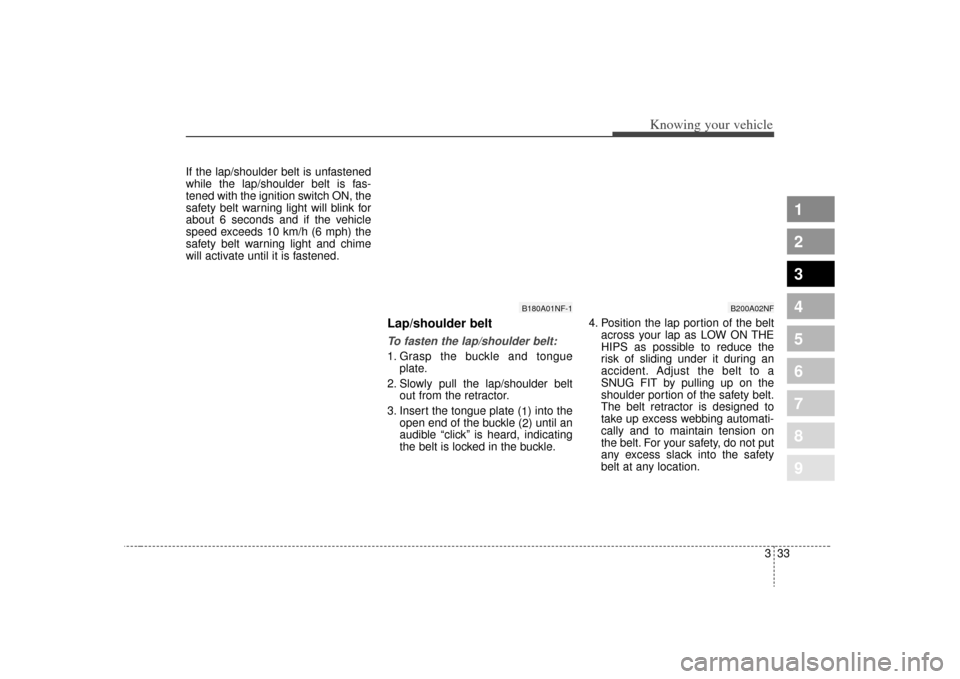
333
1
2
3
4
5
6
7
8
9
Knowing your vehicle
If the lap/shoulder belt is unfastened
while the lap/shoulder belt is fas-
tened with the ignition switch ON, the
safety belt warning light will blink for
about 6 seconds and if the vehicle
speed exceeds 10 km/h (6 mph) the
safety belt warning light and chime
will activate until it is fastened.
Lap/shoulder beltTo fasten the lap/shoulder belt:1. Grasp the buckle and tongueplate.
2. Slowly pull the lap/shoulder belt out from the retractor.
3. Insert the tongue plate ( 1) into the
open end of the buckle ( 2) until an
audible “click” is heard, indicating
the belt is locked in the buckle. 4. Position the lap portion of the belt
across your lap as LOW ON THE
HIPS as possible to reduce the
risk of sliding under it during an
accident. Adjust the belt to a
SNUG FIT by pulling up on the
shoulder portion of the safety belt.
The belt retractor is designed to
take up excess webbing automati-
cally and to maintain tension on
the belt. For your safety, do not put
any excess slack into the safety
belt at any location.
B180A01NF-1
B200A02NF
Page 44 of 291
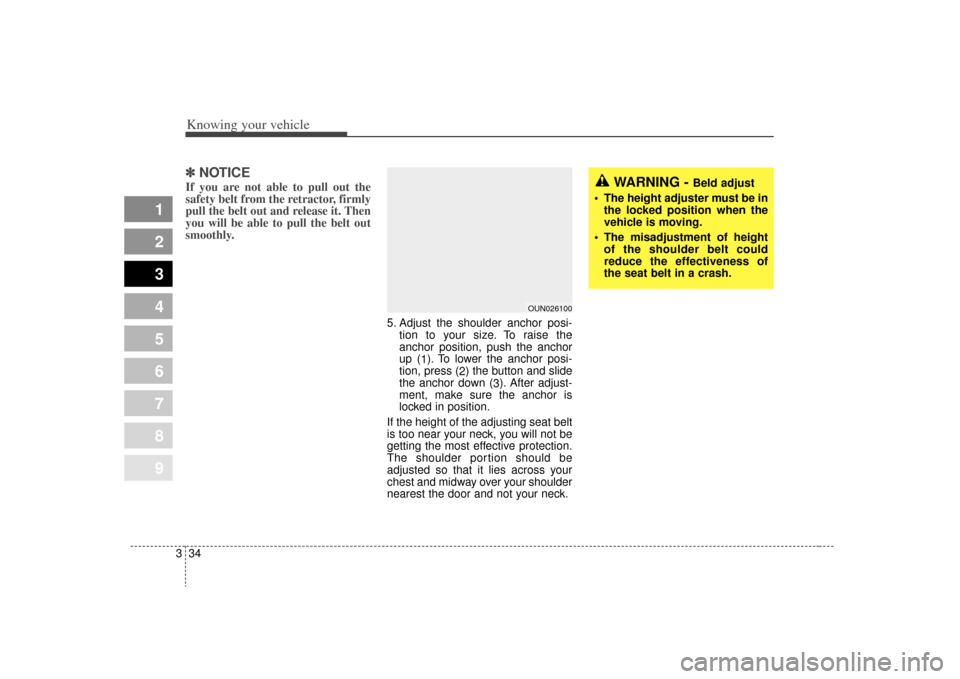
Knowing your vehicle34
3
1
2
3
4
5
6
7
8
9
✽ ✽
NOTICEIf you are not able to pull out the
safety belt from the retractor, firmly
pull the belt out and release it. Then
you will be able to pull the belt out
smoothly.
5. Adjust the shoulder anchor posi-
tion to your size. To raise the
anchor position, push the anchor
up ( 1). To lower the anchor posi-
tion, press ( 2) the button and slide
the anchor down ( 3). After adjust-
ment, make sure the anchor is
locked in position.
If the height of the adjusting seat belt
is too near your neck, you will not be
getting the most effective protection.
The shoulder portion should be
adjusted so that it lies across your
chest and midway over your shoulder
nearest the door and not your neck.
OUN026100
WARNING -
Beld adjust
The height adjuster must be in the locked position when the
vehicle is moving.
The misadjustment of height of the shoulder belt could
reduce the effectiveness of
the seat belt in a crash.
Page 46 of 291

Knowing your vehicle36
3
1
2
3
4
5
6
7
8
9
2. Insert the tongue plate (A) into the
open end of the buckle (C) until an
audible “click" is heard, indicating
the latch is locked. Make sure the
belt is not twisted. 3. Pull the tongue plate (B) and
insert the tongue plate into the
open end of the buckle (D) until an
audible “click” is heard, indicating
the latch is locked. Make sure the
belt is not twisted. There will be an audible “click” when
the tab locks in the buckle. The seat
belt automatically adjusts to the
proper length only after the lap belt is
adjusted manually so that it fits snug-
ly around your hips, if you lean for-
ward in a slow, easy motion, the belt
will extend and let you move around.
If there is a sudden stop or impact,
the belt will lock into position. It will
also lock if you try to lean forward too
quickly.
1LDN3209
WARNING
When using the rear seat center
belt, you must lock all tongue
plates and buckle/anchor con-
nector. If any tongue plate or
buckle/anchor connector is not
locked, it will increase the
chance of injury or death in the
event of collision.
1LDN3208A
Page 48 of 291
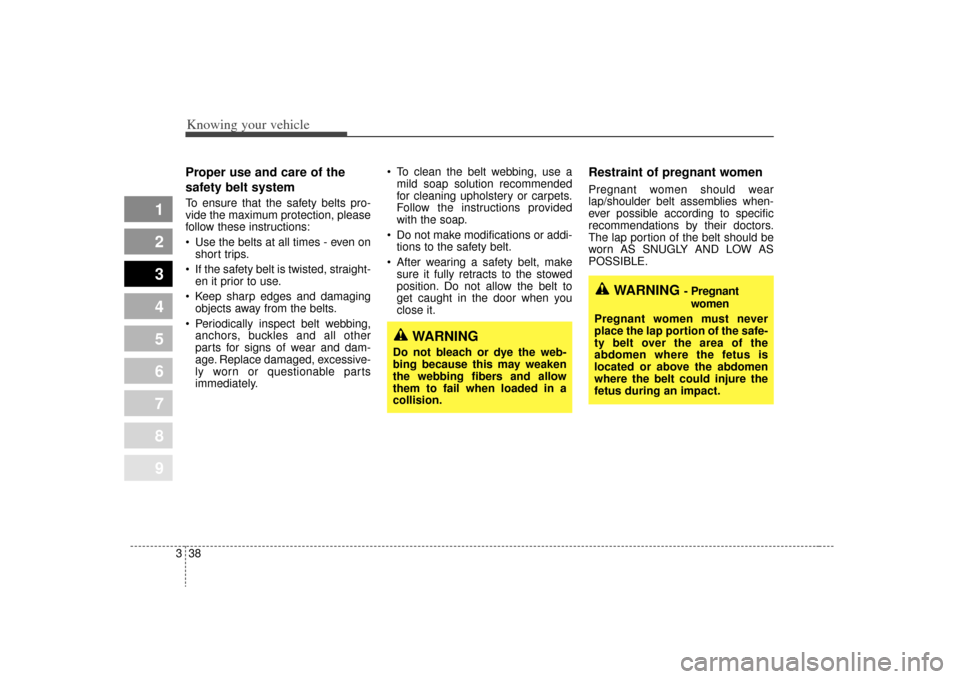
Knowing your vehicle38
3
1
2
3
4
5
6
7
8
9
Proper use and care of the
safety belt system To ensure that the safety belts pro-
vide the maximum protection, please
follow these instructions:
Use the belts at all times - even on
short trips.
If the safety belt is twisted, straight- en it prior to use.
Keep sharp edges and damaging objects away from the belts.
Periodically inspect belt webbing, anchors, buckles and all other
parts for signs of wear and dam-
age. Replace damaged, excessive-
ly worn or questionable parts
immediately. To clean the belt webbing, use a
mild soap solution recommended
for cleaning upholstery or carpets.
Follow the instructions provided
with the soap.
Do not make modifications or addi- tions to the safety belt.
After wearing a safety belt, make sure it fully retracts to the stowed
position. Do not allow the belt to
get caught in the door when you
close it.
Restraint of pregnant women Pregnant women should wear
lap/shoulder belt assemblies when-
ever possible according to specific
recommendations by their doctors.
The lap portion of the belt should be
worn AS SNUGLY AND LOW AS
POSSIBLE.
WARNING
- Pregnant
women
Pregnant women must never
place the lap portion of the safe-
ty belt over the area of the
abdomen where the fetus is
located or above the abdomen
where the belt could injure the
fetus during an impact.
WARNING
Do not bleach or dye the web-
bing because this may weaken
the webbing fibers and allow
them to fail when loaded in a
collision.
Page 49 of 291

339
1
2
3
4
5
6
7
8
9
Knowing your vehicle
Restraint of infants and small
children To increase their safety, infants and
young children should always be
restrained by a restraint system
approved for their age and size.
Never allow a child to stand or kneel
on the seat of a moving vehicle.
Never allow a safety belt to be placed
around both a child and an adult or
around two children at the same
time.
It is best for children to be seated in
the rear seats.Many companies manufacture child
restraint systems (often called child
seats) for infants and small children.
An acceptable child restraint system
must always satisfy the Safety
Standards of your country. Make
sure that any child-restraint system
you use in your vehicle is labelled as
complying with those safety stan-
dards.
The child-restraint system should be
chosen to fit both the size of the child
and the size of the vehicle seat. Be
sure to follow any instructions provid-
ed by the child-restraint system man-
ufacturer when installing the child-
restraint system.
WARNING
- Infants and
young children
Infants and young children are at much greater risk of serious
injury or death in an accident
or sudden stop if they are unre-
strained or restrained improp-
erly. Follow all instructions in
this section of your Kia manual
and the instructions that came
on and with an improved child
safety restraint system. The
child restraint must be correct-
ly installed in the vehicle, and
the child must be correctly
installed in the child restraint.
All children under 12 are safest in the back seat.
Never install a child or infant seat in the front passenger
position. The baby will be
injured or killed by the air bag
if it deploys in an accident.
Never allow a child to stand or
kneel on the seat of a moving
vehicle. Insist the child sit down
in an approved restraint system.
WARNING
- Children on laps
Never hold a child on your lap or
in your arms in a moving vehi-
cle.
Even a very strong person can-
not hold onto a child in the
event of even a minor collision.
Page 50 of 291
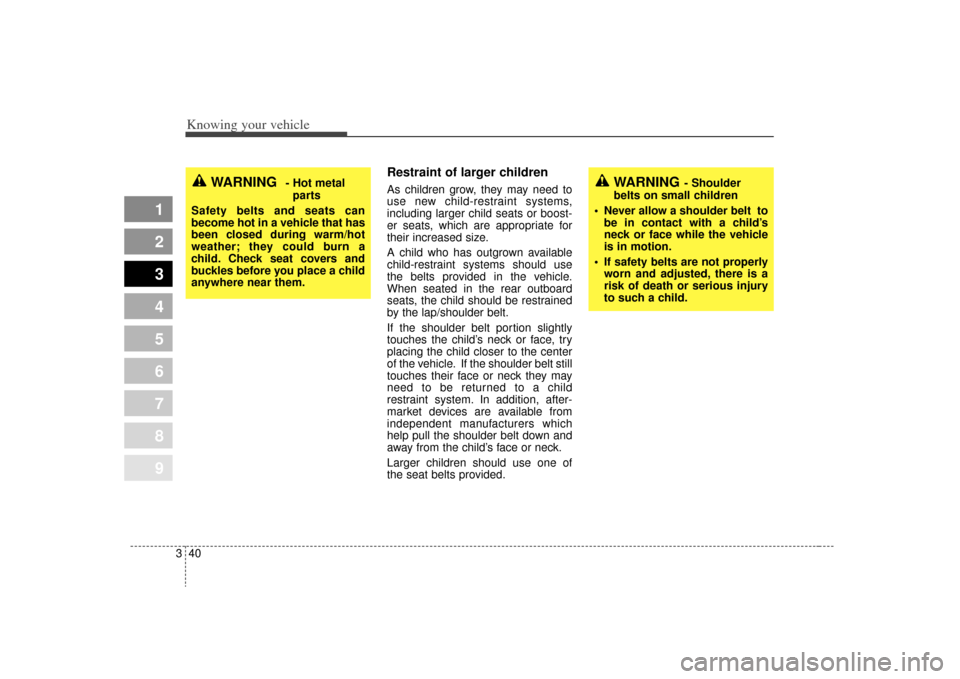
Knowing your vehicle40
3
1
2
3
4
5
6
7
8
9
Restraint of larger children As children grow, they may need to
use new child-restraint systems,
including larger child seats or boost-
er seats, which are appropriate for
their increased size.
A child who has outgrown available
child-restraint systems should use
the belts provided in the vehicle.
When seated in the rear outboard
seats, the child should be restrained
by the lap/shoulder belt.
If the shoulder belt portion slightly
touches the child’s neck or face, try
placing the child closer to the center
of the vehicle. If the shoulder belt still
touches their face or neck they may
need to be returned to a child
restraint system. In addition, after-
market devices are available from
independent manufacturers which
help pull the shoulder belt down and
away from the child’s face or neck.
Larger children should use one of
the seat belts provided.
WARNING
- Shoulder
belts on small children
Never allow a shoulder belt to be in contact with a child’s
neck or face while the vehicle
is in motion.
If safety belts are not properly worn and adjusted, there is a
risk of death or serious injury
to such a child.
WARNING
- Hot metal
parts
Safety belts and seats can
become hot in a vehicle that has
been closed during warm/hot
weather; they could burn a
child. Check seat covers and
buckles before you place a child
anywhere near them.
Page 51 of 291

341
1
2
3
4
5
6
7
8
9
Knowing your vehicle
Child restraint system
(if equipped)For small children and babies, the
use of a child seat or infant seat is
required by law. This child seat or
infant seat should be of appropriate
size for the child and should be
installed in accordance with the man-
ufacturer's instructions. It is strongly
recommended that the seat be
placed in the vehicle's rear seat
since this can make an important
contribution to safety.
Children riding in the car should sit
on the rear seat and must always be
properly restrained to minimize the
risk of injury in an accident, sudden
stop or sudden maneuver. According
to accident statistics, children are
safer when properly restrained in the
rear seats than in the front seat.
Child restraint systems are designed
to be secured in vehicle seats by lap
belts or the lap belt portion of a
lap/shoulder belt, or by a LATCH sys-
tem (if equipped).You are required by law to use safe-
ty restraints for children. If small chil-
dren ride in your vehicle you must
put them in a child restraint system
(safety seat).
Children could be injured or killed in
a crash if their restraints are not
properly secured. For small children
and babies, a child seat or infant seat
must be used. Before buying a par-
ticular child restraint system, make
sure it fits your car and seat belts,
and fits your child. Follow all the
instructions provided by the manu-
facturer when installing the child
restraint system.
ADAIR BAG
WARNING
A child restraint system must
be placed in the rear seat.
Never install a child or infant
seat on the front passenger's
seat.
Should an accident occur and
cause the passenger air bag
to deploy, it could severely
injure or kill an infant or child
seated in an infant or child
seat. Thus, only use a child
restraint in the rear seat of
your vehicle.
(Continued)
Page 53 of 291

343
1
2
3
4
5
6
7
8
9
Knowing your vehicle
Installing a child restraint system For safety reasons, we recommend
that the child restraint system be
used in the rear seats.Never place
a rear-facing child restraint in the
front passenger seat, because of
the danger that an inflating pas-
senger side air bag could impact
the rear-facing child restraint and
kill the child.
Since all passenger’s (except dri-
ver’s) safety belts move freely under
normal conditions and only lock
under extreme or emergency condi-
tions (emergency lock mode), you
must manually change these safety
belts to the auto lock mode to secure
a child restraint.✽ ✽ NOTICEThe driver’s safety belt incorporates
the emergency lock mode only.
WARNING
Do not install any child
restraint system in the front
passenger seat. Should an
accident occur and cause the
passenger air bag to deploy, it
could severely injure or kill an
infant or child seated in an
infant or child seat. Therefore,
only use a child restraint sys-
tem in the rear seat of your
vehicle.
If the child restraint seat is not anchored properly, the risk of
a child being seriously injured
or killed in a collision greatly
increases.
WARNING
Before installing the childrestraint system, read the
instructions supplied by the
child restraint system manu-
facturer.
If the seat belt does not oper- ate as described, have the
system checked immediately
by your authorized Kia dealer.
Failure to observe this manual instructions regarding child
restraint system and the
instructions provided with the
child restraint system could
increase the chance and/or
severity of injury in an acci-
dent.
Page 56 of 291
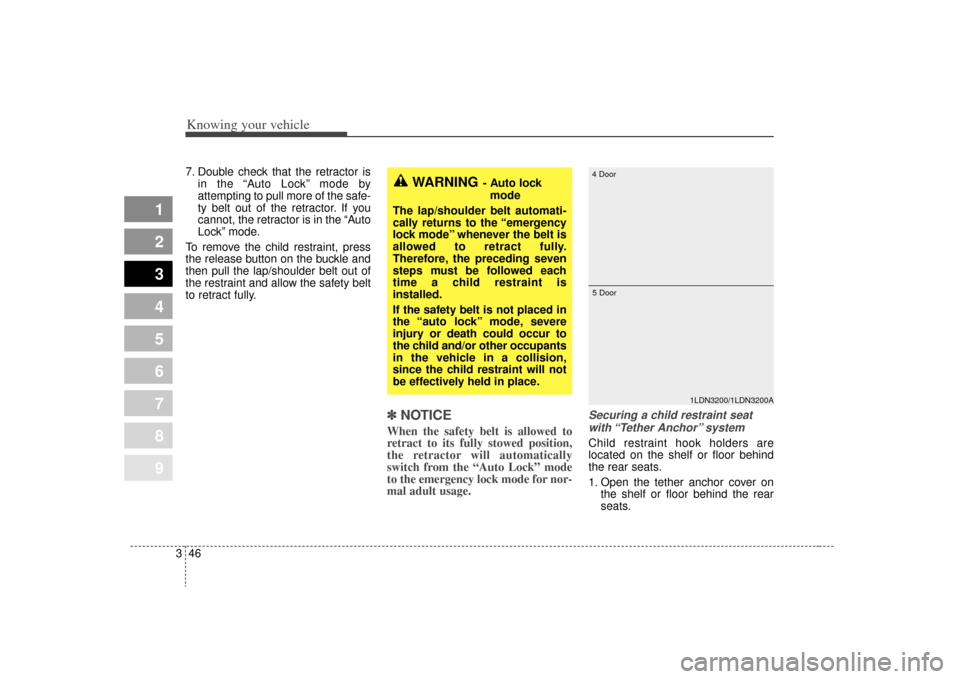
Knowing your vehicle46
3
1
2
3
4
5
6
7
8
9
7. Double check that the retractor is
in the “Auto Lock” mode by
attempting to pull more of the safe-
ty belt out of the retractor. If you
cannot, the retractor is in the “Auto
Lock” mode.
To remove the child restraint, press
the release button on the buckle and
then pull the lap/shoulder belt out of
the restraint and allow the safety belt
to retract fully.
✽ ✽ NOTICEWhen the safety belt is allowed to
retract to its fully stowed position,
the retractor will automatically
switch from the “Auto Lock” mode
to the emergency lock mode for nor-
mal adult usage.
Securing a child restraint seat
with “Tether Anchor” systemChild restraint hook holders are
located on the shelf or floor behind
the rear seats.
1. Open the tether anchor cover on the shelf or floor behind the rear
seats.
WARNING
- Auto lock
mode
The lap/shoulder belt automati-
cally returns to the “emergency
lock mode” whenever the belt is
allowed to retract fully.
Therefore, the preceding seven
steps must be followed each
time a child restraint is
installed.
If the safety belt is not placed in
the “auto lock” mode, severe
injury or death could occur to
the child and/or other occupants
in the vehicle in a collision,
since the child restraint will not
be effectively held in place.
1LDN3200/1LDN3200A
4 Door5 Door